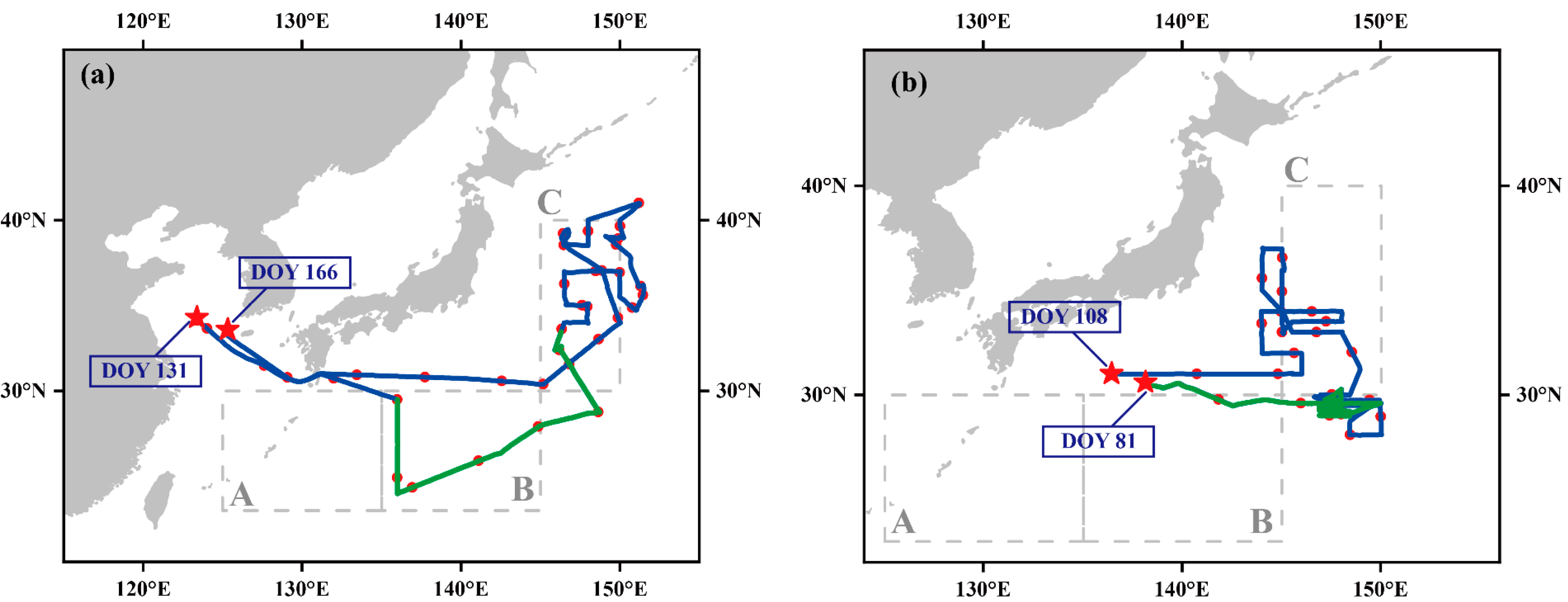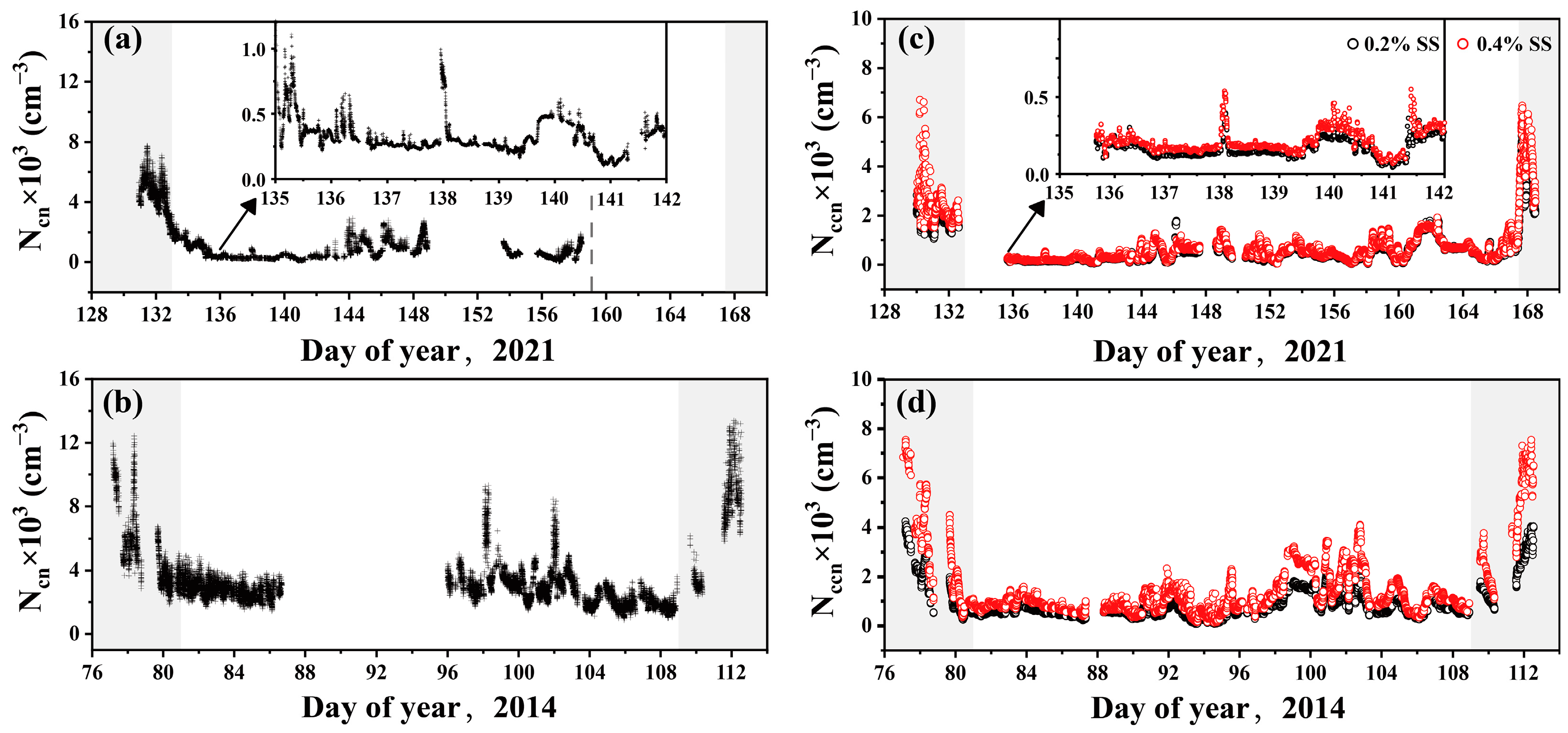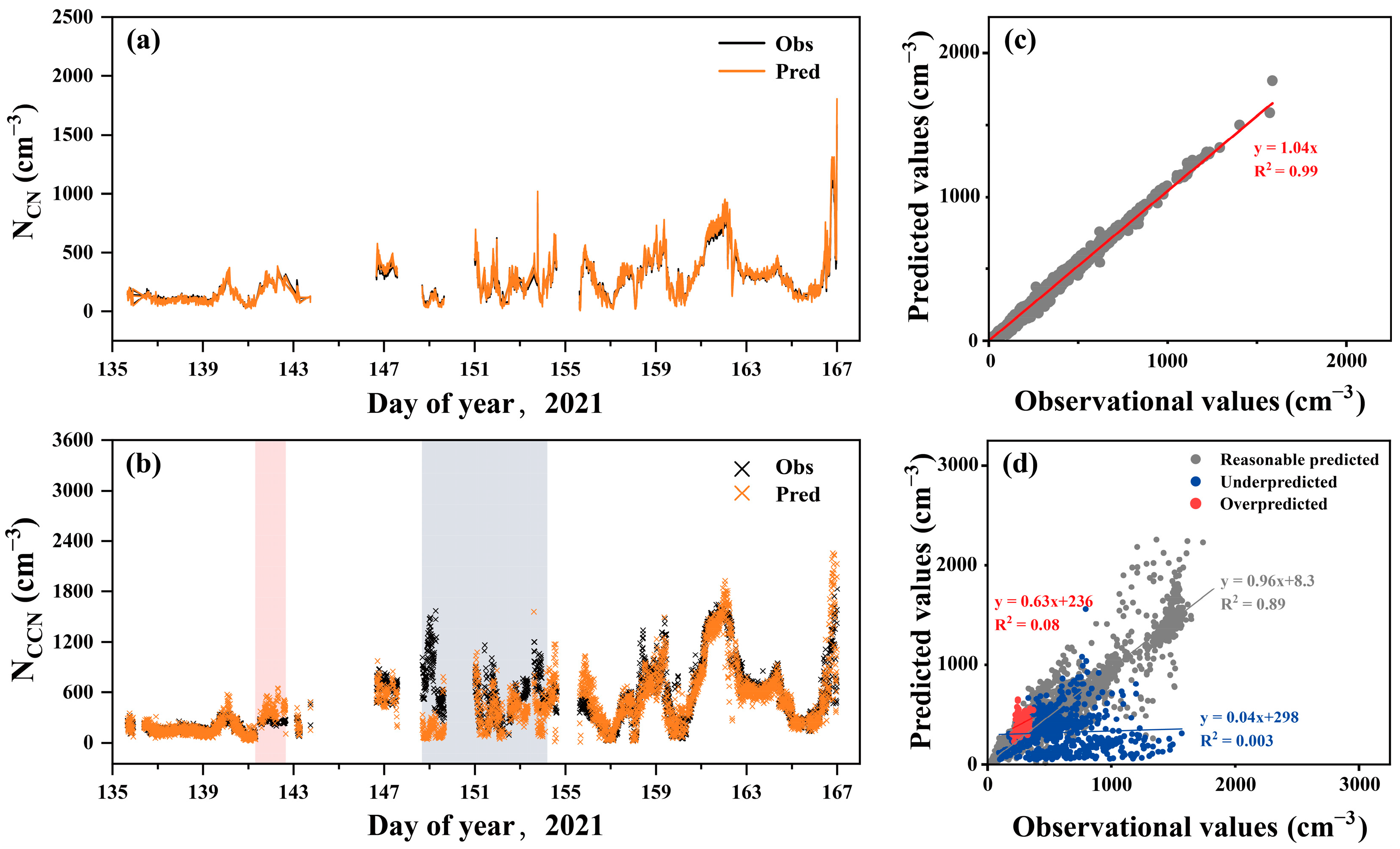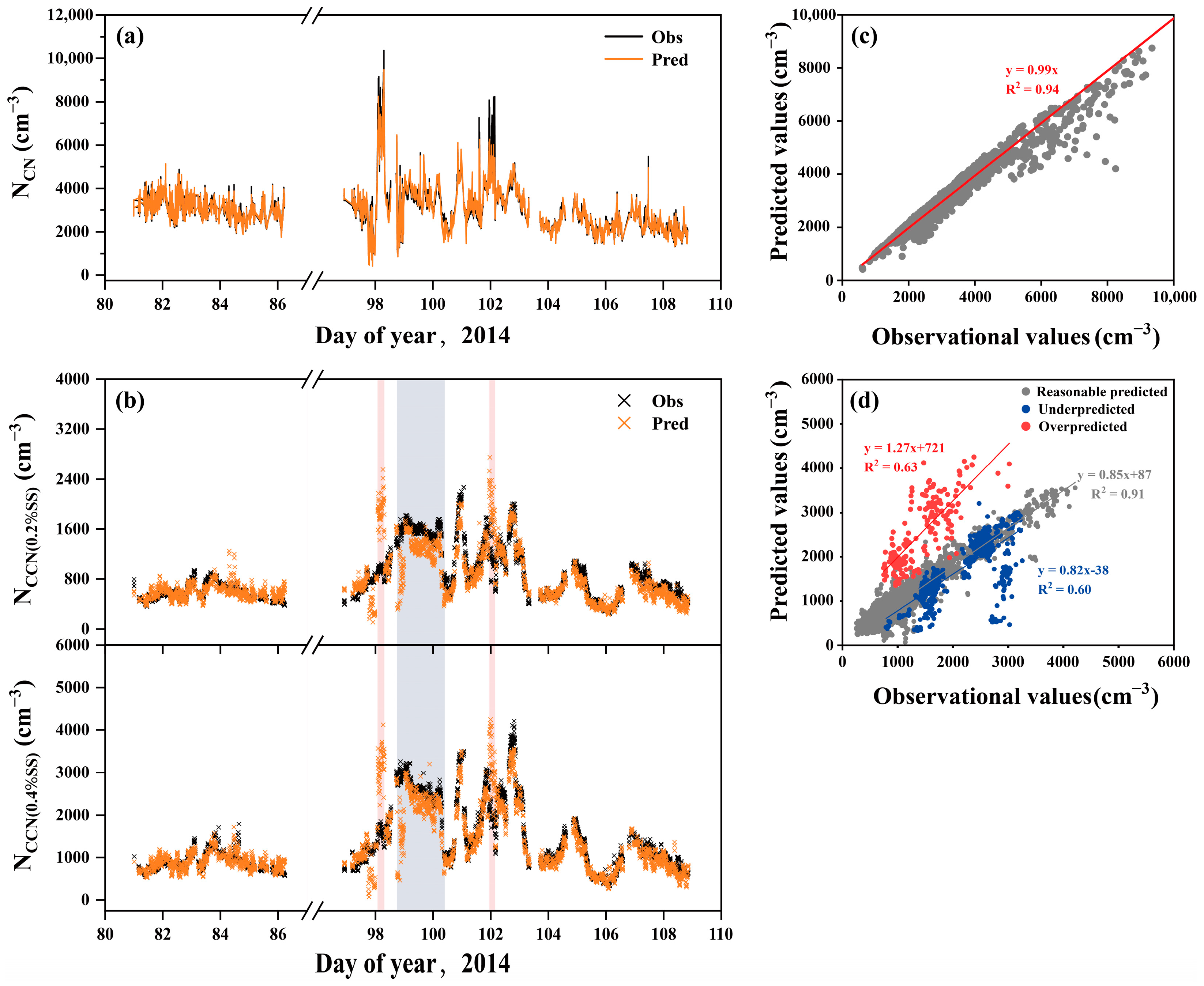Variations in Cloud Concentration Nuclei Related to Continental Air Pollution Control and Maritime Fuel Regulation over the Northwest Pacific Ocean
Abstract
1. Introduction
2. Materials and Methods
2.1. Ship-Based Measurements
2.2. Web-Based Satellite and Meteorological Data
2.3. PMF Analysis
3. Results and Discussion
3.1. Overview of the Total Ncn and Bulk Nccn Values during 2021 and 2014 Cruise Campaigns
- (1)
- We first calculated seasonal correction factors during the cruise campaigns. Here, satellite AOD data (MYD08_D3 dataset) over the NWPO were used to achieve the target (Table S1, highlighted in yellow), considering that AOD data can be statistically used to derive Nccn, e.g., Nccn at 0.4% SS = 1.2824e5 × [AOD500 × α]2.3941, where AOD500 and α represent the AOD value at 500 nm and Angstrom wavelength exponent, respectively [49,50,51,52]. The seasonal correction factors for DOY 135–167 in 2014 (referred to as Period-a-2014 thereafter), based on those obtained on DOY 74–105 in 2014 (referred to as Period-b-2014 thereafter), were 1.1 at A zone (Latitude 23.00–30.00° N and Longitude 125.00–135.00° E), 0.8 at B zone (Latitude 23.00–30.00° N and Longitude 135.00–145.00° E), and at 0.9 at C zone (Latitude 30.00–40.00° N and Longitude 145.00–150.00° E). However, the seasonal correction factors for DOY 74–105 in 2021 (referred to as Period-b-2021 thereafter), based on those obtained in Period-a-2021, largely increased to 2.9 at the A zone, 3.4 at the B zone, and 1.2 at the C zone. The latter substantial difference in the seasonal correction factors among different oceanic zones in 2021 implied that large uncertainties might exist in the correction under drastic seasonal changes in AOD (Figure S2). Thus, the latter correction factors were not used afterward. More details on the seasonal changes are presented in Supporting Information;
- (2)
- For the week-long low values in Low-Period-2021 and Low-Period-2014 at B Zone, the calculated overall decrease in Nccn at 0.4% SS on Low-Period-2021 relative to Low-Period-2014 was 66% when the seasonal correction factor of 0.8 in 2014 was used. The seasonal correction factor was also applied for Ncn and Nccn at 0.2% SS since the corresponding corrections were not well established. An 85% overall decrease in Ncn and a 60% overall decrease in Nccn at 0.2% SS can be obtained. All the seasonality-corrected decreases further supported large impacts of air pollutant emission reduction on Ncn and Nccn over the NWPO. However, the seasonal correction suffered from a certain degree of uncertainty, as those aforementioned calculations were for different periods. However, no more accurate method of seasonal correction is available so far because of the limited observational data in the remote marine atmosphere.
3.2. Source Apportionment of Ncn and Nccn during 2021 and 2014 Cruises
- (1)
- The differences in Nccn contribution from Factor 3 in 2014 and the combined contributions of Factors 2 and 3 in 2021 during the low Nccn weeks (Low-Period-2021 and Low-Period-2014) were 6 cm−3 and 59 cm−3 (on average) at 0.2% and 0.4% SS, respectively. This negligible difference between the two years at 0.2% SS implied that the contributions to Nccn from sea-spray aerosols plus marine traffic during the comparison periods might be roughly the same at that SS; the D-value of (59–6) cm−3 between 0.2% and 0.4% SS suggested that a reduction in Nccn by approximately 53 cm−3 at 0.4% SS is due to the FCS regulation over the NWPO during the low Nccn weeks. Moreover, it can be assumed that the contributions of sea-spray aerosols plus marine traffic to Nccn were less affected by the seasonal change in 1–2 months. Seasonal correction was thereby unnecessary for the estimation;
- (2)
- In a broader analysis including all data from the NWPO, the differences were −62 cm−3 and −14 cm−3 at 0.2% and 0.4% SS, respectively. The difference of −62 cm−3 Nccn could be attributed to various short-period factors, e.g., increased sea-spray aerosol contributions in 2021 with self-vessel wave-broken effects enhanced for the forward deck sampling and other unidentified causes; however, the influences from the various short-period factors can be largely canceled out in estimating the D-value of (−14 − (−62)) cm−3 at 0.2% and 0.4% SS. The D-value suggested that the FCS regulation led to a decrease in Nccn by 48 cm−3;
- (3)
- Integrating insights from (1) and (2), it can be inferred that the FCS regulation, implemented since 2020, likely resulted in a decrease of Nccn by ~50 cm−3 at 0.4% SS over the NWPO. However, its impact at 0.2% SS seems to be minimal.
3.3. A 10–20% Misprediction of Nccn by the PMF and Uncertainty
3.4. Indirect Climate Effects via Satellite-Based Cloud Parameters
4. Conclusions and Implications
Supplementary Materials
Author Contributions
Funding
Institutional Review Board Statement
Informed Consent Statement
Data Availability Statement
Conflicts of Interest
References
- Asadnabizadeh, M. Critical findings of the sixth assessment report (AR6) of working Group I of the intergovernmental panel on climate change (IPCC) for global climate change policymaking a summary for policymakers (SPM) analysis. Int. J. Clim. Chang. Strateg. Manag. 2023, 15, 652–670. [Google Scholar] [CrossRef]
- Bellouin, N.; Quaas, J.; Gryspeerdt, E.; Kinne, S.; Stier, P.; Watson-Parris, D.; Boucher, O.; Carslaw, K.S.; Christensen, M.; Daniau, A.L.; et al. Bounding global aerosol radiative forcing of climate change. Rev. Geophys. 2020, 58, e2019RG000660. [Google Scholar] [CrossRef] [PubMed]
- Twomey, S. Aerosols, clouds and radiation. Atmos. Environ. Part A Gen. Top. 1991, 25, 2435–2442. [Google Scholar] [CrossRef]
- Ito, A.; Miyazaki, Y.; Taketani, F.; Iwamoto, Y.; Kanaya, Y. Marine aerosol feedback on biogeochemical cycles and the climate in the Anthropocene: Lessons learned from the Pacific Ocean. Environ. Sci. Atmos. 2023, 3, 782–798. [Google Scholar] [CrossRef]
- Kawana, K.; Miyazaki, Y.; Omori, Y.; Tanimoto, H.; Kagami, S.; Suzuki, K.; Yamashita, Y.; Nishioka, J.; Deng, Y.; Yai, H.; et al. Number-size distribution and CCN activity of atmospheric aerosols in the Western North Pacific during spring pre-bloom period: Influences of terrestrial and marine sources. J. Geophys. Res. Atmos. 2022, 127, e2022JD036690. [Google Scholar] [CrossRef]
- Liang, B.; Cai, M.; Sun, Q.; Zhou, S.; Zhao, J. Source apportionment of marine atmospheric aerosols in northern South China Sea during summertime 2018. Environ. Pollut. 2021, 289, 117948. [Google Scholar] [CrossRef]
- Sanchez, K.J.; Chen, C.-L.; Russell, L.M.; Betha, R.; Liu, J.; Price, D.J.; Massoli, P.; Ziemba, L.D.; Crosbie, E.C.; Moore, R.H.; et al. Substantial seasonal contribution of observed biogenic sulfate particles to cloud condensation nuclei. Sci. Rep. 2018, 8, 3225. [Google Scholar] [CrossRef]
- Santos, L.F.E.D.; Salo, K.; Kong, X.; Noda, J.; Kristensen, T.B.; Ohigashi, T.; Thomson, E.S. Changes in CCN activity of ship exhaust particles induced by fuel sulfur content reduction and wet scrubbing. Environ. Sci. Atmos. 2023, 3, 182–195. [Google Scholar] [CrossRef]
- Simpkins, G. Aerosol-cloud interactions. Nat. Clim. Chang. 2018, 8, 457. [Google Scholar] [CrossRef]
- Song, C.; Becagli, S.; Beddows, D.C.S.; Brean, J.; Browse, J.; Dai, Q.; Dall’Osto, M.; Ferracci, V.; Harrison, R.M.; Harris, N.; et al. Understanding sources and drivers of size-resolved aerosol in the high Arctic islands of Svalbard using a receptor model coupled with machine learning. Environ. Sci. Technol. 2022, 56, 11189–11198. [Google Scholar] [CrossRef]
- Zhu, Y.; Li, K.; Shen, Y.; Gao, Y.; Liu, X.; Yu, Y.; Gao, H.; Yao, X. New particle formation in the marine atmosphere during seven cruise campaigns. Atmos. Chem. Phys. 2019, 19, 89–113. [Google Scholar] [CrossRef]
- Abbatt, J.P.D.; Leaitch, W.R.; Aliabadi, A.A.; Bertram, A.K.; Blanchet, J.-P.; Boivin-Rioux, A.; Bozem, H.; Burkart, J.; Chang, R.Y.W.; Charette, J.; et al. Overview paper: New insights into aerosol and climate in the Arctic. Atmos. Chem. Phys. 2019, 19, 2527–2560. [Google Scholar] [CrossRef]
- Miller, R.M.; Rauber, R.M.; Di Girolamo, L.; Rilloraza, M.; Fu, D.; McFarquhar, G.M.; Nesbitt, S.W.; Ziemba, L.D.; Woods, S.; Thornhill, K.L. Influence of natural and anthropogenic aerosols on cloud base droplet sizedistributions in clouds over the South China Sea and West Pacific. Atmos. Chem. Phys. 2023, 23, 8959–8977. [Google Scholar] [CrossRef]
- Behrenfeld, M.J.; Moore, R.H.; Hostetler, C.A.; Graff, J.; Gaube, P.; Russell, L.M.; Chen, G.; Doney, S.C.; Giovannoni, S.; Liu, H.; et al. The North Atlantic Aerosol and Marine Ecosystem Study (NAAMES): Science motive and mission overview. Front. Mar. Sci. 2019, 6, 122. [Google Scholar] [CrossRef]
- Dadashazar, H.; Painemal, D.; Alipanah, M.; Brunke, M.; Chellappan, S.; Corral, A.F.; Crosbie, E.; Kirschler, S.; Liu, H.; Moore, R.H.; et al. Cloud drop number concentrations over the western North Atlantic Ocean: Seasonal cycle, aerosol interrelationships, and other influential factors. Atmos. Chem. Phys. 2021, 21, 10499–10526. [Google Scholar] [CrossRef] [PubMed]
- Williamson, C.J.; Kupc, A.; Axisa, D.; Bilsback, K.R.; Bui, T.; Campuzano-Jost, P.; Dollner, M.; Froyd, K.D.; Hodshire, A.L.; Jimenez, J.L.; et al. A large source of cloud condensation nuclei from new particle formation in the tropics. Nature 2019, 574, 399–403. [Google Scholar] [CrossRef] [PubMed]
- Chang, R.Y.W.; Abbatt, J.P.D.; Boyer, M.C.; Chaubey, J.P.; Collins, D.B. Characterizing the hygroscopicity of growing particles in the Canadian Arctic summer. Atmos. Chem. Phys. 2022, 22, 8059–8071. [Google Scholar] [CrossRef]
- Kurokawa, J.; Ohara, T. Long-term historical trends in air pollutant emissions in Asia: Regional Emission inventory in ASia (REAS) version 3. Atmos. Chem. Phys. 2020, 20, 12761–12793. [Google Scholar] [CrossRef]
- Massling, A.; Leinert, S.; Wiedensohler, A.; Covert, D. Hygroscopic growth of sub-micrometer and one-micrometer aerosol particles measured during ACE-Asia. Atmos. Chem. Phys. 2007, 7, 3249–3259. [Google Scholar] [CrossRef]
- Nagao, I.; Matsumoto, K.; Tanaka, H. Characteristics of dimethylsulfide, ozone, aerosols, and cloud condensation nuclei in air masses over the northwestern Pacific Ocean. J. Geophys. Res. Atmos. 1999, 104, 11675–11693. [Google Scholar] [CrossRef]
- Uematsu, M.; Toratani, M.; Kajino, M.; Narita, Y.; Senga, Y.; Kimoto, T. Enhancement of primary productivity in the western North Pacific caused by the eruption of the Miyake-jima Volcano. Geophys. Res. Lett. 2004, 31, L06106. [Google Scholar] [CrossRef]
- Wang, Y.; Wang, M.; Zhang, R.; Ghan, S.J.; Lin, Y.; Hu, J.; Pan, B.; Levy, M.; Jiang, J.H.; Molina, M.J. Assessing the effects of anthropogenic aerosols on Pacific storm track using a multiscale global climate model. Proc. Natl. Acad. Sci. USA 2014, 111, 6894–6899. [Google Scholar] [CrossRef]
- Wang, Y.; Zhu, Y.; Wang, M.; Rosenfeld, D.; Gao, Y.; Yao, X.; Sheng, L.; Efraim, A.; Wang, J. Validation of satellite-retrieved CCN based on a cruise campaign over the polluted Northwestern Pacific ocean. Atmos. Res. 2021, 260, 105722. [Google Scholar] [CrossRef]
- Zhu, Y.; Shen, Y.; Li, K.; Meng, H.; Sun, Y.; Yao, X.; Gao, H.; Xue, L.; Wang, W. Investigation of particle number concentrations and new particle formation with largely reduced air pollutant emissions at a coastal semi-urban site in northern China. J. Geophys. Res. Atmos. 2021, 126, e2021JD035419. [Google Scholar] [CrossRef]
- Li, S.; Wang, S.; Wu, Q.; Zhang, Y.; Ouyang, D.; Zheng, H.; Han, L.; Qiu, X.; Wen, Y.; Liu, M.; et al. Emission trends of air pollutants and CO2 in China from 2005 to 2021. Earth Syst. Sci. Data 2023, 15, 2279–2294. [Google Scholar] [CrossRef]
- Zhao, Y.; Xi, M.; Zhang, Q.; Dong, Z.; Ma, M.; Zhou, K.; Xu, W.; Xing, J.; Zheng, B.; Wen, Z.; et al. Decline in bulk deposition of air pollutants in China lags behind reductions in emissions. Nat. Geosci. 2022, 15, 190–195. [Google Scholar] [CrossRef]
- Shang, D.; Tang, L.; Fang, X.; Wang, L.; Yang, S.; Wu, Z.; Chen, S.; Li, X.; Zeng, L.; Guo, S.; et al. Variations in source contributions of particle number concentration under long-term emission control in winter of urban Beijing. Environ. Pollut. 2022, 304, 119072. [Google Scholar] [CrossRef] [PubMed]
- MarineTraffic: Global Ship Tracking Intelligence. Available online: https://www.marinetraffic.com (accessed on 5 September 2023).
- Gao, Y.; Zhang, D.; Wang, J.; Gao, H.; Yao, X. Variations in Ncn and Nccn over marginal seas in China related to marine traffic emissions, new particle formation and aerosol aging. Atmos. Chem. Phys. 2020, 20, 9665–9677. [Google Scholar] [CrossRef]
- Kuittinen, N.; Jalkanen, J.-P.; Alanen, J.; Ntziachristos, L.; Hannuniemi, H.; Johansson, L.; Karjalainen, P.; Saukko, E.; Isotalo, M.; Aakko-Saksa, P.; et al. Shipping remains a globally significant source of anthropogenic PN emissions even after 2020 sulfur regulation. Environ. Sci. Technol. 2021, 55, 129–138. [Google Scholar] [CrossRef]
- Wang, J.; Shen, Y.; Li, K.; Gao, Y.; Gao, H.; Yao, X. Nucleation-mode particle pool and large increases in Ncn and Nccn observed over the northwestern Pacific Ocean in the spring of 2014. Atmos. Chem. Phys. 2019, 19, 8845–8861. [Google Scholar] [CrossRef]
- Jeong, C.-H.; Evans, G.J. Inter-comparison of a fast mobility particle sizer and a scanning mobility particle sizer incorporating an ultrafine water-based condensation particle counter. Aerosol Sci. Technol. 2009, 43, 364–373. [Google Scholar] [CrossRef]
- Gong, J.; Zhu, Y.; Chen, D.; Gao, H.; Shen, Y.; Gao, Y.; Yao, X. The occurrence of lower-than-expected bulk Nccn values over the marginal seas of China- Implications for competitive activation of marine aerosols. Sci. Total Environ. 2023, 858, 159938. [Google Scholar] [CrossRef] [PubMed]
- Chen, D.; Shen, Y.; Wang, J.; Gao, Y.; Gao, H.; Yao, X. Mapping gaseous dimethylamine, trimethylamine, ammonia, and their particulate counterparts in marine atmospheres of China’s marginal seas—Part 1: Differentiating marine emission from continental transport. Atmos. Chem. Phys. 2021, 21, 16413–16425. [Google Scholar] [CrossRef]
- Li, J.; Jian, B.; Huang, J.; Hu, Y.; Zhao, C.; Kawamoto, K.; Liao, S.; Wu, M. Long-term variation of cloud droplet number concentrations from space-based Lidar. Remote Sens. Environ. 2018, 213, 144–161. [Google Scholar] [CrossRef]
- Xiong, C.; Li, J.; Liu, Z.; Zhang, Z. The dominant role of aerosol-cloud interactions in aerosol-boundary layer feedback: Case studies in three megacities in China. Front. Environ. Sci. 2022, 10, 1002412. [Google Scholar] [CrossRef]
- Grosvenor, D.P.; Sourdeval, O.; Zuidema, P.; Ackerman, A.; Alexandrov, M.D.; Bennartz, R.; Boers, R.; Cairns, B.; Chiu, J.C.; Christensen, M.; et al. Remote sensing of droplet number concentration in warm clouds: A review of the current state of knowledge and perspectives. Rev. Geophys. 2018, 56, 409–453. [Google Scholar] [CrossRef] [PubMed]
- Vu, T.V.; Delgado-Saborit, J.M.; Harrison, R.M. Review: Particle number size distributions from seven major sources and implications for source apportionment studies. Atmos. Environ. 2015, 122, 114–132. [Google Scholar] [CrossRef]
- Ogulei, D.; Hopke, P.; Chalupa, D.; Utell, M. Modeling source contributions to submicron particle number concentrations measured in Rochester, New York. Aerosol Sci. Technol. 2007, 41, 179–201. [Google Scholar] [CrossRef]
- Cai, J.; Chu, B.; Yao, L.; Yan, C.; Heikkinen, L.M.; Zheng, F.; Li, C.; Fan, X.; Zhang, S.; Yang, D.; et al. Size-segregated particle number and mass concentrations from different emission sources in urban Beijing. Atmos. Chem. Phys. 2020, 20, 12721–12740. [Google Scholar] [CrossRef]
- Du, W.; Zhao, J.; Wang, Y.; Zhang, Y.; Wang, Q.; Xu, W.; Chen, C.; Han, T.; Zhang, F.; Li, Z.; et al. Simultaneous measurements of particle number size distributions at ground level and 260m on a meteorological tower in urban Beijing, China. Atmos. Chem. Phys. 2017, 17, 6797–6811. [Google Scholar] [CrossRef]
- Mochida, M.; Nishita-Hara, C.; Furutani, H.; Miyazaki, Y.; Jung, J.; Kawamura, K.; Uematsu, M. Hygroscopicity and cloud condensation nucleus activity of marine aerosol particles over the western North Pacific. J. Geophys. Res. Atmos. 2011, 116, D06204. [Google Scholar] [CrossRef]
- Mochida, M.; Nishita-Hara, C.; Kitamori, Y.; Aggarwal, S.G.; Kawamura, K.; Miura, K.; Takami, A. Size-segregated measurements of cloud condensation nucleus activity and hygroscopic growth for aerosols at Cape Hedo, Japan, in spring 2008. J. Geophys. Res. Atmos. 2010, 115, D21207. [Google Scholar] [CrossRef]
- Quinn, P.K.; Bates, T.S. The case against climate regulation via oceanic phytoplankton sulphur emissions. Nature 2011, 480, 51–56. [Google Scholar] [CrossRef] [PubMed]
- Sanchez, K.J.J.; Painemal, D.; Brown, M.D.D.; Crosbie, E.C.C.; Gallo, F.; Hair, J.W.W.; Hostetler, C.A.A.; Jordan, C.E.E.; Robinson, C.E.E.; Scarino, A.J.; et al. Multi-campaign ship and aircraft observations of marine cloud condensation nuclei and droplet concentrations. Sci. Data 2023, 10, 471. [Google Scholar] [CrossRef] [PubMed]
- Takegawa, N.; Moteki, N.; Oshima, N.; Koike, M.; Kita, K.; Shimizu, A.; Sugimoto, N.; Kondo, Y. Variability of aerosol particle number concentrations observed over the western Pacific in the spring of 2009. J. Geophys. Res. Atmos. 2014, 119, 13474–13488. [Google Scholar] [CrossRef]
- Ueda, S.; Miura, K.; Kawata, R.; Furutani, H.; Uematsu, M.; Omori, Y.; Tanimoto, H. Number-size distribution of aerosol particles and new particle formation events in tropical and subtropical Pacific Oceans. Atmos. Environ. 2016, 142, 324–339. [Google Scholar] [CrossRef]
- Buzorius, G.; McNaughton, C.S.; Clarke, A.D.; Covert, D.S.; Blomquist, B.; Nielsen, K.; Brechtel, F.J. Secondary aerosol formation in continental outflow conditions during ACE-Asia. J. Geophys. Res. Atmos. 2004, 109, D24203. [Google Scholar] [CrossRef]
- Ahn, S.H.; Yoon, Y.J.; Choi, T.J.; Lee, J.Y.; Kim, Y.P.; Lee, B.Y.; Ritter, C.; Aas, W.; Krejci, R.; Strom, J.; et al. Relationship between cloud condensation nuclei (CCN) concentration and aerosol optical depth in the Arctic region. Atmos. Environ. 2021, 267, 118748. [Google Scholar] [CrossRef]
- Andreae, M.O. Correlation between cloud condensation nuclei concentration and aerosol optical thickness in remote and polluted regions. Atmos. Chem. Phys. 2009, 9, 543–556. [Google Scholar] [CrossRef]
- Liu, J.; Li, Z. Estimation of cloud condensation nuclei concentration from aerosol optical quantities: Influential factors and uncertainties. Atmos. Chem. Phys. 2014, 14, 471–483. [Google Scholar] [CrossRef]
- Painemal, D.; Chang, F.-L.; Ferrare, R.; Burton, S.; Li, Z.; Smith, W.L., Jr.; Minnis, P.; Feng, Y.; Clayton, M. Reducing uncertainties in satellite estimates of aerosol-cloud interactions over the subtropical ocean by integrating vertically resolved aerosol observations. Atmos. Chem. Phys. 2020, 20, 7167–7177. [Google Scholar] [CrossRef]
- Hoppel, W.A.; Fitzgerald, J.W.; Frick, G.M.; Larson, R.E.; Mack, E.J. Aerosol size distributions and optical properties found in the marine boundary layer over the Atlantic Ocean. J. Geophys. Res. Atmos. 1990, 95, 3659–3686. [Google Scholar] [CrossRef]
- Hoppel, W.A.; Frick, G.M. Submicron aerosol size distributions measured over the tropical and South Pacific. Atmos. Environment. Part A Gen. Top. 1990, 24, 645–659. [Google Scholar] [CrossRef]
- Dusek, U.; Frank, G.P.; Hildebrandt, L.; Curtius, J.; Schneider, J.; Walter, S.; Chand, D.; Drewnick, F.; Hings, S.; Jung, D.; et al. Size matters more than chemistry for cloud-nucleating ability of aerosol particles. Science 2006, 312, 1375–1378. [Google Scholar] [CrossRef]
- Alanen, J.; Isotalo, M.; Kuittinen, N.; Simonen, P.; Martikainen, S.; Kuuluvainen, H.; Honkanen, M.; Lehtoranta, K.; Nyyssonen, S.; Vesala, H.; et al. Physical characteristics of particle emissions from a medium speed ship engine fueled with natural gas and low-sulfur liquid fuels. Environ. Sci. Technol. 2020, 54, 5376–5384. [Google Scholar] [CrossRef] [PubMed]
- Burkart, J.; Hodshire, A.L.; Mungall, E.L.; Pierce, J.R.; Collins, D.B.; Ladino, L.A.; Lee, A.K.Y.; Irish, V.; Wentzell, J.J.B.; Liggio, J.; et al. Organic condensation and particle growth to CCN sizes in the summertime marine Arctic is driven by materials more semivolatile than at continental sites. Geophys. Res. Lett. 2017, 44, 10725–10734. [Google Scholar] [CrossRef]
- Yu, C.; Pasternak, D.; Lee, J.; Yang, M.; Bell, T.; Bower, K.; Wu, H.; Liu, D.; Reed, C.; Bauguitte, S.; et al. Characterizing the particle composition and cloud condensation nuclei from shipping emission in Western Europe. Environ. Sci. Technol. 2020, 54, 15604–15612. [Google Scholar] [CrossRef]
- Gong, S.L. A parameterization of sea-salt aerosol source function for sub- and super-micron particles. Glob. Biogeochem. Cycles 2003, 17, 1097. [Google Scholar] [CrossRef]
- Russell, L.M.; Moore, R.H.; Burrows, S.M.; Quinn, P.K. Ocean flux of salt, sulfate, and organic components to atmospheric aerosol. Earth Sci. Rev. 2023, 239, 104364. [Google Scholar] [CrossRef]
- Kecorius, S.; Hoffmann, E.H.; Tilgner, A.; Barrientos-Velasco, C.; van Pinxteren, M.; Zeppenfeld, S.; Vogl, T.; Madueno, L.; Lovric, M.; Wiedensohler, A.; et al. Rapid growth of Aitken-mode particles during Arctic summer by fog chemical processing and its implication. Pnas Nexus 2023, 2, pgad124. [Google Scholar] [CrossRef]
- Shen, Y.; Meng, H.; Yao, X.; Peng, Z.; Sun, Y.; Zhang, J.; Gao, Y.; Feng, L.; Liu, X.; Gao, H. Does ambient secondary conversion or the prolonged fast conversion in combustion plumes cause severe PM2.5 air pollution in China? Atmosphere 2022, 13, 673. [Google Scholar] [CrossRef]
- Royer, H.M.; Poehlker, M.L.; Krueger, O.; Blades, E.; Sealy, P.; Lata, N.N.; Cheng, Z.; China, S.; Ault, A.P.; Quinn, P.K.; et al. African smoke particles act as cloud condensation nuclei in the wintertime tropical North Atlantic boundary layer over Barbados. Atmos. Chem. Phys. 2023, 23, 981–998. [Google Scholar] [CrossRef]
- Quinn, P.K.; Coffman, D.J.; Johnson, J.E.; Upchurch, L.M.; Bates, T.S. Small fraction of marine cloud condensation nuclei made up of sea spray aerosol. Nat. Geosci. 2017, 10, 674–679. [Google Scholar] [CrossRef]
- Xu, W.; Ovadnevaite, J.; Fossum, K.N.; Lin, C.; Huang, R.-J.; Ceburnis, D.; O’Dowd, C. Sea spray as an obscured source for marine cloud nuclei. Nat. Geosci. 2022, 15, 282–286. [Google Scholar] [CrossRef]
- Wang, Q.; He, X.; Huang, X.H.H.; Griffith, S.M.; Feng, Y.; Zhang, T.; Zhang, Q.; Wu, D.; Yu, J.Z. Impact of secondary organic aerosol tracers on tracer-based source apportionment of organic carbon and PM2.5: A case study in the Pearl River Delta, China. Acs Earth Space Chem. 2017, 1, 562–571. [Google Scholar] [CrossRef]
- Jia, H.; Ma, X.; Yu, F.; Liu, Y.; Yin, Y. Distinct impacts of increased aerosols on cloud droplet number concentration of stratus/stratocumulus and cumulus. Geophys. Res. Lett. 2019, 46, 13517–13525. [Google Scholar] [CrossRef]
- Iwamoto, Y.; Watanabe, A.; Kataoka, R.; Uematsu, M.; Miura, K. Aerosol-cloud interaction at the summit of Mt. Fuji, Japan: Factors influencing cloud droplet number concentrations. Appl. Sci. 2021, 11, 8439. [Google Scholar] [CrossRef]
- Pruppacher, H.R.; Klett, J.D. Microphysics of Clouds and Precipitation; Springer Nature: Dordrecht, The Netherlands, 1980. [Google Scholar] [CrossRef]







Disclaimer/Publisher’s Note: The statements, opinions and data contained in all publications are solely those of the individual author(s) and contributor(s) and not of MDPI and/or the editor(s). MDPI and/or the editor(s) disclaim responsibility for any injury to people or property resulting from any ideas, methods, instructions or products referred to in the content. |
© 2024 by the authors. Licensee MDPI, Basel, Switzerland. This article is an open access article distributed under the terms and conditions of the Creative Commons Attribution (CC BY) license (https://creativecommons.org/licenses/by/4.0/).
Share and Cite
Sun, L.; Cui, W.; Ma, N.; Hong, J.; Zhu, Y.; Gao, Y.; Gao, H.; Yao, X. Variations in Cloud Concentration Nuclei Related to Continental Air Pollution Control and Maritime Fuel Regulation over the Northwest Pacific Ocean. Atmosphere 2024, 15, 972. https://doi.org/10.3390/atmos15080972
Sun L, Cui W, Ma N, Hong J, Zhu Y, Gao Y, Gao H, Yao X. Variations in Cloud Concentration Nuclei Related to Continental Air Pollution Control and Maritime Fuel Regulation over the Northwest Pacific Ocean. Atmosphere. 2024; 15(8):972. https://doi.org/10.3390/atmos15080972
Chicago/Turabian StyleSun, Lei, Wenxin Cui, Nan Ma, Juan Hong, Yujiao Zhu, Yang Gao, Huiwang Gao, and Xiaohong Yao. 2024. "Variations in Cloud Concentration Nuclei Related to Continental Air Pollution Control and Maritime Fuel Regulation over the Northwest Pacific Ocean" Atmosphere 15, no. 8: 972. https://doi.org/10.3390/atmos15080972
APA StyleSun, L., Cui, W., Ma, N., Hong, J., Zhu, Y., Gao, Y., Gao, H., & Yao, X. (2024). Variations in Cloud Concentration Nuclei Related to Continental Air Pollution Control and Maritime Fuel Regulation over the Northwest Pacific Ocean. Atmosphere, 15(8), 972. https://doi.org/10.3390/atmos15080972











